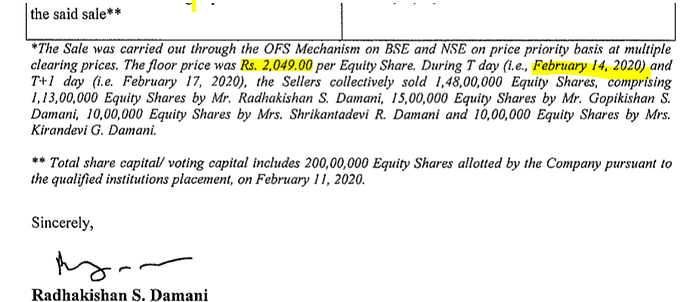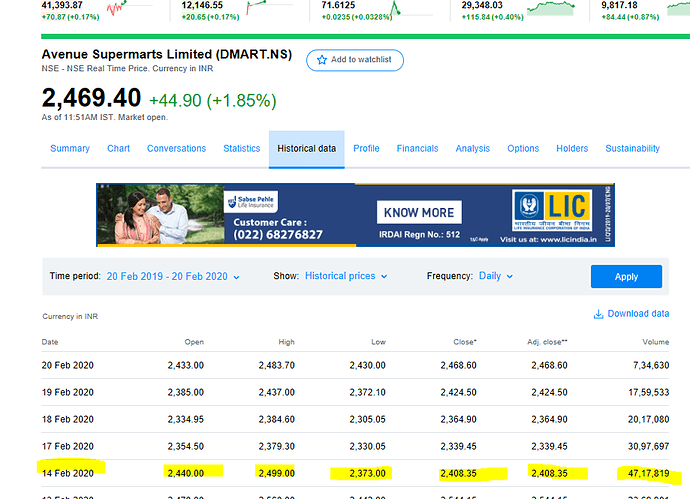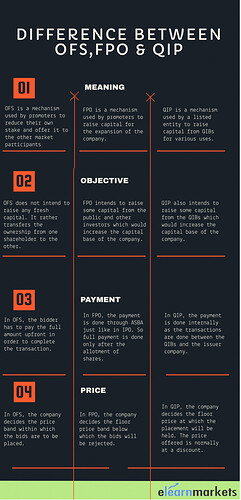Promoter offered them at floor price of 2049, its the mutual funds and HNIs who pushed the price to 2316
Perfect, it has already hit a low of 2305 well below 2316 set as floor price for retailers. Based on retail subscription, rough calculation shows that OFS allotment for retailers will be above 2318.10
company has filed report to exchnages which is below about bulk sale through OFS window mechanism
https://www.bseindia.com/xml-data/corpfiling/AttachLive/F58B89E6_9FBA_4F3A_904D_C1427C8DF1A3_074151.PDF
in that document company had mentioned the price of share when the transaction made Rs 2049 in T day i.e Feb 14,2020 but when i checked at the yahoo finance i found different set of data
Data at yahoo finance
what i made out of this that It means the Promoter are selling below the market rate and indirectly benefiting he purchasers . It is definitely a REG FLAG and raised question about the integrity and correctness of reporting correctness . I may be wrong at my perceptions Fellow VP may negate my perception .
details of OFS mechanism of sale
https://www.bseindia.com/Static/PublicIssues/aboutOFS.aspx
EVERY hypothesis has right to be WRONG and can be Questioned - Anonymous
Regards
Disc : not invested this is not any recommendation to buy sell or hold i am not any sebi approved analyst
All OFSs are done at a rate lower to the prevailing market price. In almost all such cases, the stock price comes quite close to the OFS price or in some cases goes below that.
However, DMART stock remained way above the OFS price of 2049.
Regards,
Suhag
that was the floor price for the sale. it was not neccesarily the sale price
You are correct that’s the reason i raised a concern that Why the Damani has accepted offer he has no hurry to decrease his stack and accept the price which is far below the market price . as per sebi company’s had given period of 1 Year to be within the prescribed Limits . so indirectly benefitting the buyers .He is Old fox of the market . and know every bits and bytes of mechanism how capital market works .
Regards
The actual sale price was much higher at 2316/- (read the previous posts) arrived by the subscription of non-retail category on 14th. This price briefly touched by market as well (2310/- and went up again) on February 18th after retail portion also FULLY subscribed on 17th by retail and T+1 option for non retail. So even though promoters brought down stake to 74.99% as required, I feel the key is that they could sell much above floor price since there was good interest to buy at higher price by institutions.
Disc: Took a small position at Cut off price for retailers at 2316/- using OFS
Have you got it credited in your demat & if yes what is exact transaction price. As there were bids at cut off price and above that as well. The retail bids at cutoff were much less than 10% allocated quota of retail.
I got it credited by next day morning tradiing session (18th Feb) and the cost was cut off price (2316.00) as bid by me with 100% margin money. (Below cut-off price there was no allocation to retail as well as per exchange filing). Also I noticed that on 17th much higher than the number of shares offered to retail bucket was bid by non-retail as well using T+1 option at or above cut-off price. So I think whoever offered to buy at cut-off or above from retail would have got allocation and the remaining must have went to non-retail.
I also noticed that if needed I could have bought at lower than cut off from market itself next day for a short window. Now float is increased, but need to see if price will get corrected or not as valuation is very steep as of now.
Imho theres simple logic for ofs to be below mkt price else why would one not buy from mkt only directly ? Secondly all investors got a chance to bid . So theres no question favoring one over the other IMHO
Avenue Supermarts –Investment ThesisAvenue Supermarts-Investment Thesis.pdf (607.7 KB)
Few points which I would like to put forward are:
- The QIP /ofs has been to reduce promotor stake.Therefore the money would not accrue to the company
2)The estimated stores expansion per year seems v high keeping in view that they just have 200 stores in 20 years - New stores would generate sales but EBITA would be lower to attract new customers
Views invited.
Shares offered in OFS was owned by promoters but why QIP money should go to promoters pocket?
350 stores in next 5 years is too aggressive but they can add average 30-35 stores per year in next 5 years.
Even QIP was done to reduce promotor’s stake and therefore I believe the proceeds would go to promotor and not the company.
QIP or Qualified Institutional Placement is largely a fund raising tool for the listed companies. Description: QIP is a process which was introduced by SEBI so as to enable the listed companies to raise finance through the issue of securities to qualified institutional buyers (QIBs).
It raised Rs 4,098 crore via QIP from participants such as government of Singapore and ICICI Prudential Bluechip Fund among others. After the QIP, promoter stake in firm got diluted to 77.27% from nearly 80%. The QIP issue of Avenue Supermarts opened on February 5, 2020 and closed on February 10.
Hope it clarifies.
When equity expands, promoter stake is bound to dilute. QIP money will come to the company.
Sir, Please read one of my posts where they opened 200th store in ChikkaBallapur [which is an industrial town]: Avenue Supermart: a compounding machine? - #1415 by kingzeusvj
Till now, Dmart was majorly focussed on Metros and Tier 1 Cities [barring Maharahtra]; but Chikkabalapur was an exception [and I would say pretty surprising exception after 199 stores]; which only throws light on their vision of 350 stores in next 5 years.
So let me throw your question “Is 350 stores in 5 years possible” back to you.
However, just to cut the conversation let’s wait for 1 year and then see what I am saying is right or not?



